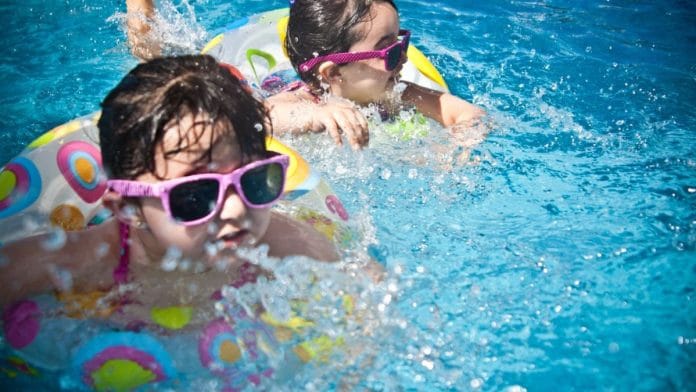Swimming season is finally here, and your children will itch to jump into that nice, cold chlorine pool—except that it can be harsh on their delicate and sensitive skin. As important as chlorine is for maintaining pool hygiene, it can strip a child’s skin of its natural oils, leading to dryness, rashes, itchiness, irritation and even acne.
As a dermatologist, I have some special tips and tricks for young swimmers and their parents so that they can enjoy their pool time without skin troubles.
Watch out for these four problems
Swimmer’s xerosis or dry skin: When we swim, the natural protective oils on our skin, known as sebum—get diluted and washed away. As a result, the outermost layer of the skin loses its moisture, leaving us with a parched, scaly, and itchy sensation. And those long, hot showers after swimming can worsen dry skin by further depleting moisture. So, if you want your child’s skin to be happy and hydrated, keep those showers shorter and use ample moisturiser after every swimming session.
Swimmer’s itch: Also known as cercarial dermatitis, swimmer’s itch is an allergic reaction caused by tiny larvae from freshwater flatworms called schistosomes. When one takes a dip in infested waters, these little critters can burrow into the skin and cause trouble in the form of itchy red bumps. However, these usually go away on their own within a few days. Just remember to avoid such areas in the future and give the skin some time to heal. You can also use cold packs on the affected areas tosoothe the itchiness and reduce inflammation. Taking oral antihistamines can also help alleviate the allergic reaction.
Green Hair: Have you ever noticed swimmers with green hair? It’s a common occurrence, especially for those with lighter hair. The culprit behind this colourful transformation is chlorine, which reacts with minerals like copper to turn your hair green. But fear not. You can combat this issue by using a swimmer’s shampoo, or, if you prefer a do-it-yourself approach, after swimming. Grab some tomato juice, white vinegar, or lemon juice and pour about half a cup onto your child’s hair. Then, give it a good comb. These acidic substances work their magic by removing the copper compounds that cause the green colour.
Rashes: Chlorine, sunscreen, swimsuits, and pool water can cause irritating rashes. The good news, however, is that they can be easily cleared up. But to prevent them, always take a lukewarm shower after swimming, hand wash your child’s swimsuit regularly to avoid bacteria buildup, apply a fragrance-free protective lotion before getting into the water, and consider using a rash guard to minimise skin contact with pool chemicals.
Also read: India’s low hygiene gives it more immunity against virus, helps in Covid fight — CSIR study
Pre-swimming care
Dress smart for the pool: Choose loose clothes that let your child’s skin breathe. Opt for swimming suits made of polyester instead of nylon and spandex, as they offer superior protection against pool chlorine. If your children are relaxing by the poolside, make them wear a hat and sunglasses for added protection.
Check pool hygiene: For a safer swimming experience, consider opting for indoor pools – especially during the peak afternoon hours between 11:30 AM and 1:30 PM –to avoid harsh sun rays. Additionally, it is essential to choose a pool that maintains good hygiene. Even one swimmer with poor hygiene can transmit contagious viral infections such as warts, chicken pox and herpes labialis (cold sores). Make sure that the people using the pool are knowledgeable about hygiene practices.
Nourish the skin: Before heading to the pool, apply a thick moisturiser all over your child’s body to keep their skin hydrated and protected. Choose natural options like jojoba oil or Vitamin E-enriched coconut or baby oils—or look for moisturisers with shea butter.
Next, apply a generous amount of gel-based, waterproof, broad-spectrum SPF 30+ sunscreen to safeguard their skin from harmful UV rays. Don’t forget to reapply every few hours. Try natural alternatives like aloe vera or cucumber to combat tanning.
It is also important to encourage your child to take a quick shower before entering the pool. This helps to remove any impurities from their skin and prepares them for chlorine exposure. They should also drink plenty of fluids before their swimming session to keep dehydration and cramps at bay.
Post-swimming care
Warm baths: After swimming, treat your child to a warm, relaxing bath using a gentle moisturising soap to wash away chlorine residue. Don’t forget to give their scalp and hair some love with a nourishing shampoo.
Moisturise again: Post-bath, generously moisturise their skin with natural oils like almond or coconut, leaving them with a delightful scent and well-hydrated skin.
Remove that tan: Combat tan lines by applying papaya paste to the affected areas at home. This natural remedy works wonders in lightening the skin and reducing the effects of tanning.
The tips in this article are not only beneficial for children but also for adults. They can sometimes experience similar skin and hair problems and have comparable immunity levels. With the right knowledge and preventive measures, you can make their swimming experience worry-free.
Dr Deepali Bhardwaj is a dermatologist, anti-allergy specialist, laser surgeon and internationally trained aesthetician. She tweets @dermatdoc. Views are personal.
(Edited by Zoya Bhatti)






